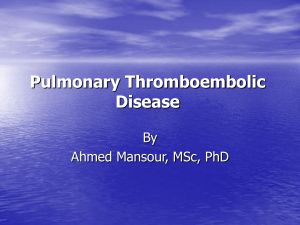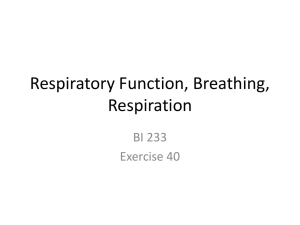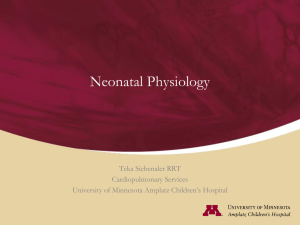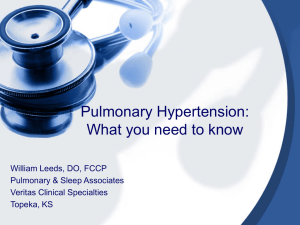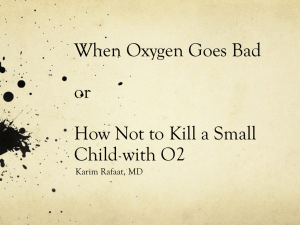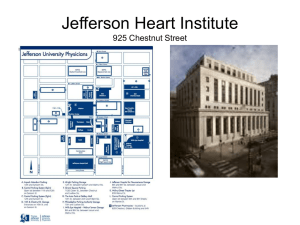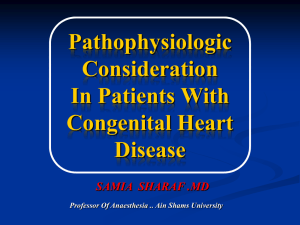Lecture 3 Vascular and Pleural
advertisement
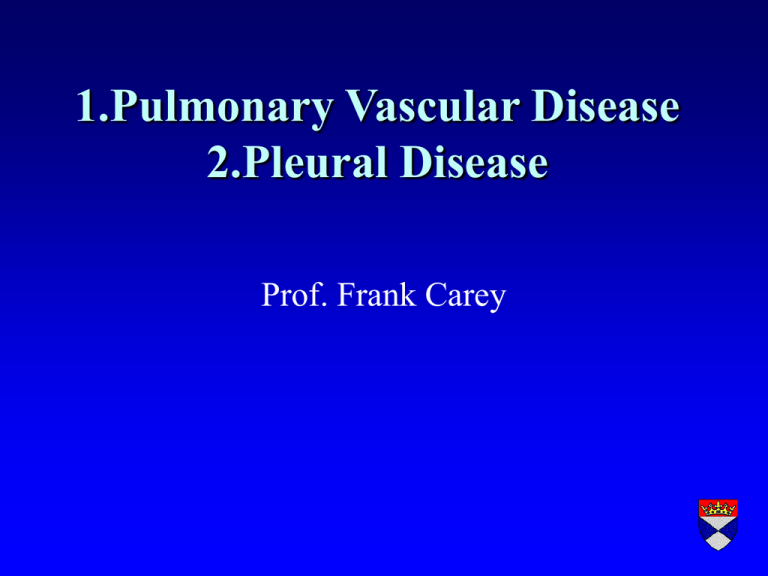
1.Pulmonary Vascular Disease 2.Pleural Disease Prof. Frank Carey Pulmonary Circulatuion Dual supply Pulmonary arteries Bronchial arteries Low pressure system Pulmonary artery receives entire cardiac output (a filter) Low pressure system…. Thin walled vessels Low incidence of atherosclerosis At normal pressures Pulmonary Oedema Accumulation of fluid in the lung Interstitium Alveolar spaces Causes a restrictive pattern of disease Pulmonary Oedema (causes) Haemodynamic ( hydrostatic pressure) Due to cellular injury 1. 2. Alveolar lining cells ii. Alveolar endothelium Localised – pneumonia Generalised – adult respiratory distress syndrome (ARDS) i. ARDS Diffuse alveolar damage syndrome (DADS) Shock lung Causes include sepsis, diffuse infection (virus, mycoplasma), severe trauma, oxygen Pathogenesis of ARDS Injury (eg bacterial endotoxin) Infiltration of inflammatory cells Cytokines Oxygen free radicals Injury to cell membranes Pathology of ARDS Fibrinous exudate lining alveolar walls (hyaline membranes) Cellular regeneration Inflammation ARDS with hyaline membrane ARDS – cellular reaction Outcome of ARDS Death Resolution Fibrosis (chronic restrictive lung disease Neonatal RDS Premature infants Deficient in surfactant (type 2 alveolar lining cells Increased effort in expanding lung physical damage to cells Embolus A detached intravascular mass carried by the blood to a site in the body distant from its point of origin Most emboli are thrombi – others include gas, fat, foreign bodies and tumour clumps Pulmonary Embolus Common Often subclinical An important cause of sudden death and pulmonary hypertension 95% + of emboli are thromboemboli Source of most pulmonary emboli….. Deep limbs venous thrombosis (DVT) of lower Risk factors for PE are those for DVT…. 1. 2. 3. Factors in vessel wall (eg endothelial hypoxia) Abnormal blood flow (venous stasis) Hypercoaguable blood (cancer patients, post-MI etc) - Virchow’s triad Effects of PE Sudden death Severe chest pain/dyspnoea/haemoptysis Pulmonary infarction Pulmonary hypertension Effects of PE depend on… Size of embolus Cardiac function Respiratory function Effect of embolus size… Large emboli Death Infarction Severe symptoms Small emboli Clinically silent Recurrent pulmonary hypertension Pulmonary Infarct (ischaemic necrosis) Embolus necessary but not sufficient Bronchial artery supply compromised (eg in cardiac failure) Pummonary Embolus Pulmonary infarct – tumour embolus Pulmonary Hypertension Primary (rare, young women) Secondary Pulmonary Hypertension (mechanisms) Hypoxia (vascular constriction) Increased flow through pulmonary circulation (congenital heart disease) Blockage (PE) or loss (emphysema) of pulmonary vascular bed Back pressure from left sided heart failure Morphology of pulmonary hypertension Medial hypertrophy of arteries Intimal thickening (fibrosis) Atheroma Right ventricular hypertrophy Extreme cases (congenital heart disease, primary pulmonary hypertension) – plexogenic change/necrosis Pulmonary artery – intimal fibrosis Plexiform lesion – primary pulmonary hypertension “Cor Pulmonale” Pulmonary hypertension complicating lung disease Right ventricular hypertrophy Right ventricular dilatation Right heart failure (swollen legs, congested liver etc) Cardiomegaly due to right ventricular dilatation Right ventricular hypertrophy and dilatation The Pleura A mesothelial surface lining the lungs and mediastinum Mesothelial cells designed for fluid absorption Hallmark of disease is the effusion Pleural Effusion Transudate (low protein) cardiac failure hypoproteinaemia Exudate (high protein) pneumonia TB connective tissue disease malignancy (primary or metastatic) Pleural effusion Purulent Effusion Full of acute inflammatory cells Empyema Can become chronic Pneumothorax Air in pleural space Trauma Rupture of bulla Large bullae Pleural Neoplasia Primary benign (rare) malignant mesothelioma Secondary common (adenocarcinomas - lung, GIT, ovary) Mesothelioma Asbestosis related Increasing incidence Mixed epithelial/mesenchymal differentiation Dismal prognosis Mesothelioma Pleural biopsy - mesothelioma Metastases in Pleura Differential diagnosis of malignant effusions….. Cytology, biopsy Difficult Immunohistochemistry for lineage specific antigens may help Medicolegal importance



